L. Usongo and J. Nagahuedi
Leonard Usongo is Senior Conservation Biologist, World Wide Fund for Nature (WWF) Central Africa Regional Programme Office (CARPO), Yaoundé, Cameroon.
Jonas Nagahuedi is Executive Secretary, Central African Forests Commission (Commission des forêts d’Afrique Centrale, COMIFAC), Yaoundé, Cameroon.
Adapted from a paper presented at the symposium “Our Common Ground: Innovations in Land Use Decision-Making”, 8–9 May 2007, Vancouver, Canada.
Central Africa’s conservation approach is based on land-use planning in 12 priority landscapes, involving establishment of core protected areas surrounded by multiple-use zones.
Central Africa holds over 15 percent of the world’s remaining tropical forest, the second largest contiguous forest on the planet. The forest provides food, raw materials, freshwater and shelter for over 75 million people and is a major source of wealth for the region. However, forest resources are threatened by overexploitation, clearing for agriculture and commercial bushmeat trade, all exacerbated by high population growth.
As described in this article, the Yaoundé process, the Central African Forests Commission (COMIFAC) and the Congo Basin Forest Partnership (CBFP) provide an enabling institutional environment fostering regional cooperation in forest conservation and rural development based on effective land-use planning. The core of the Convergence Plan endorsed by COMIFAC countries in 2002 – the road map for conservation initiatives in the Congo Basin – is land-use planning in 12 priority landscapes, which are large ecosystems with consistent biological and socio-economic features. These landscapes were selected using an ecoregional planning approach based on assessment of ecosystem representativeness, biodiversity significance, socio-economic importance and geopolitical and strategic factors. The participatory selection process involved national governments, conservation organizations and local stakeholders.
The tropical forests of Central Africa cover more than 193 million hectares – an area almost four times the size of France (CBFP, 2006; ITTO, 2004). About 76 percent of the total forest area is production forest (Table 1) (CBFP, 2006). Lying at the equator, the region harbours among the richest concentrations of terrestrial biodiversity in the world. Although records are incomplete, the Congo Basin is known to be home to over 10 000 species of plants, perhaps 80 percent of which are endemic. The region supports the world’s largest assemblage of tropical forest vertebrates: about 1 000 bird species (16 threatened, 36 percent endemic) and some 400 mammals which include 23 threatened species such as western and eastern gorillas, chimpanzees, bonobos (pygmy chimpanzees) and forest elephants (WWF, 2002). The Congo is the world’s second richest river system for fish (700 species) and is distinguished by exceptional levels of endemism in both fish and molluscs. The Congo Basin forests also provide valuable global ecological services by absorbing and storing carbon dioxide, thereby helping to slow the rate of global climate change.
The Congo Basin contains four of Africa’s freshwater ecoregions identified by the World Wide Fund for Nature (WWF, 2008) as globally outstanding for their high diversity of freshwater species. Between 75 and 95 percent of the rainfall in the Congo Basin is estimated to come from recycled water generated by evapotranspiration within the region. In this feature the region differs dramatically from other major tropical watersheds of the world; the Amazon Basin, for example, recycles only about 50 percent of its water (WWF, 2002). For this reason, central African forests are probably more sensitive and less resilient ecologically than other tropical moist forests.
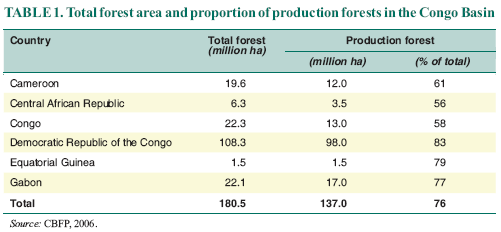 |
Central African nations rank among the lowest in the world on most human welfare indicators and among the highest in population growth and fertility (Table 2). All countries in Central Africa except Gabon (which has relatively high urbanization and per capita income) have high population growth rates and a predominantly young population. Low literacy rates and lack of education, particularly among women, are recognized factors in the high fertility rates and are critical issues facing both conservation and human development in Central Africa. High population growth rates ultimately also affect the environment.
Ethnically, the main tribal groups living in the Congo Basin are Bantu groups and pygmies. Baka, BaAka and Bakola pygmies were formerly hunter-gatherers but are now becoming increasingly settled, both through their own choice and because of government policies. They have a largely interdependent social relationship with the Bantu made complex by ethnic rivalries.
Bantu farmers practice slash-and-burn subsistence agriculture; forest is felled and burned, providing nutrients for the crops. In addition to food crops, many farmers maintain small plots of cocoa grown under shade. Cocoa is grown for export and its production is thus linked to world market prices.
All the nations in the region are dependent on extractive industries (oil, mining, timber, wildlife and other non-wood forest products [NWFPs]) for a large percentage of their gross domestic product (GDP), almost all their foreign exchange and much of their tax revenues. Well capitalized and technically competent multinational corporations dominate most extractive industries except artisanal gold and diamond mining.
The region’s forests are a major source of local and national economic growth with revenues generated from logging, mining, hunting, fishing and trade in other NWFPs. The timber industry is an important source of national revenue and employment in all countries in Central Africa and will be a major determinant of the future state of forests in the region (Brunner and Ekoko, 2000). Timber exports contribute at least 40 percent of national GDP. Export of primary wood products from Cameroon, the Central African Republic, the Congo, the Democratic Republic of the Congo and Gabon generated US$995 million in 2003 (ITTO, 2004).
Wildlife also provides important revenue and employment, in particular for rural communities. In most of Central Africa, the rural revenue produced by both legal and illegal trade in bushmeat is probably equivalent or even superior to that produced by the logging industry. Wildlife killed as food in Central Africa amounts to 1 million tonnes each year (Eves et al., 2002). Bushmeat cheaply provides a varied source of high-quality protein. It contributes between 30 and 80 percent of the protein consumed by forest-dwelling families in the Congo Basin. Furthermore, bushmeat hunting is a low-risk economic activity requiring almost no capital investment and producing very quick financial returns. Therefore sustainable village hunting has an important role in alleviating poverty among the most economically vulnerable people.
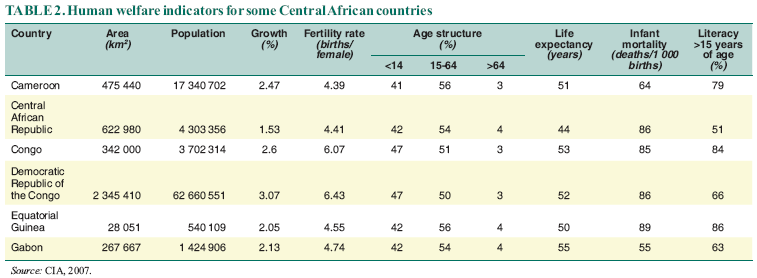 |
| Baka pygmies, indigenous hunter-gatherers in the forests of southeastern Cameroon, are increasingly becoming settled |
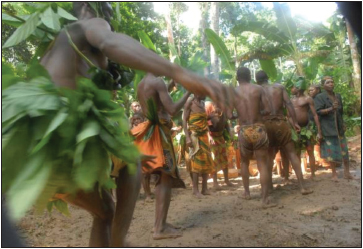 |
D. Rouge |
The rich resource base of the Congo Basin provides immense opportunities for economic growth and sustainable development. However, much of the resource use and development has been uncoordinated, uncontrolled and unsustainable. Future threats to biodiversity are estimated to be high throughout the region (Figure 1). Allowing further environmental degradation to occur will diminish the very resources on which future economic development and the livelihoods of the people depend.
The threats to the Congo Basin have a number of diverse and interlinked root causes. These include local and global demands for forest products such as timber, meat and ivory – which are frequently met through unsustainable means of production – as well as global mineral and oil markets. Many NWFPs are also overexploited. Problems are compounded by inadequacies in both funding and capacity for sustainable resource management at all levels, and the lack of alternative livelihood opportunities for local people engaged in unsustainable production.
Climate change is also likely to have important impacts on forests and river basins. Although the science of predicting the regional impacts of global warming is still in its infancy, most models predict approximately a 1 mm per day increase in rainfall across most of the Congo Basin by 2050, assuming a 1 percent per year increase in carbon dioxide (CO2) (Parenti and Hanna, 2007).
The World Resources Institute (WRI, 2000) estimates that 50 to 90 percent of central Africa’s forests outside protected areas are under logging concessions; for example, 81 percent of Cameroon’s forest is available for logging. Many loggers are not accountable to forestry administrations and other stakeholders seeking sustainable forest management.
Unsustainable logging is also a threat to wildlife habitat. However, with current unsustainable levels of hunting, many wildlife species will not survive long enough to be impacted by habitat loss (Sayer and Campbell, 2004).
Hunting for the commercial bushmeat trade is the primary threat to animal biodiversity in the Congo Basin. Pigs, primates, rodents and especially duikers (small forest antelope) are the most commonly hunted animals in the forest (Hochschild, 1998; Wilkie et al., 2000). Regional and international demand (especially from China) for ivory is also driving the poaching of elephants. Unsustainable hunting threatens local extirpation of many vertebrates and regional species extinction for several large mammals, birds and reptiles.
Hunting is linked to logging, not only because of increased consumption of bushmeat within concession areas, but also because logging leads to improved road infrastructure and increased movement of people, in turn facilitating the supply of bushmeat to urban markets and enhancing the profitability of the trade through increased turnover rates.
The human population in the region is expected to double in 25 to 30 years (CIA, 2007). If the demand continues to grow as expected, and consumers do not or are unable to switch to eating meat from domestic livestock, then hunting of wild game will increase in the future. This will place most large mammals at risk of local or regional extinction.
Today, most people in the Congo Basin rely on shifting cultivation and small-scale permanent agriculture to provide their non-protein dietary needs. With population growing at the rate of 2 to 3 percent per year, clearing for agricultural purposes will constitute a major threat to forests in the long term.
If agricultural practices do not intensify and remain largely unchanged, most forests in the ecoregion might be converted to agricultural lands by the year 2025. Even in Gabon, where 60 percent of the population of 1 million lives in cities, over 20 000 km2 of forest might be lost or degraded over the next 25 years, assuming that most food in Gabon is produced domestically (see Table 1 for the current situation). In Cameroon, increasing deforestation and forest degradation could affect more than 50 percent of forest.
| 1 Future biodiversity threat |
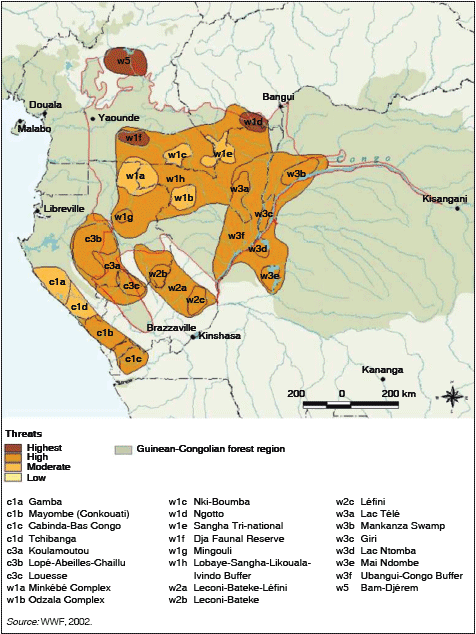 |
| Unsustainable logging is a threat to wildlife habitat and thus to the livelihoods of rural people who obtain revenue and employment from wildlife (lowland gorilla, Lobeke National Park, Cameroon) |
 |
D. Rouge |
The legal regimes in the different countries of the subregion are committed to long-term sustainable use of forest resources and to biodiversity protection; all require management plans for logging and other management interventions.
Land tenure systems remain a source of tension, with both State ownership and traditional land rights in the same area. There are essentially two parallel systems: the formal system, regulated by statute, in which land is owned and title is obtained; and a traditional system in which land use is regulated according to clan ownership. Legally, forests and natural resources such as minerals, timber and wildlife belong to the State, while rural communities, living on land that they regard as theirs by ancestry, are allowed usufruct rights.
In terms of land-use planning, forests are divided into permanent and non-permanent domains. In the permanent domain are the State forests (forêts domaniales), including national parks, wildlife reserves, hunting zones, game ranches, zoological gardens, wildlife sanctuaries, buffer zones, strict nature reserves, production forests and protection forests.
The non-permanent forests (or in Gabon rural forest, domaine forestier rural) are those that are not legally required to remain forest in the long term. In Cameroon the non-permanent forests include all community forests and forests belonging to private persons.
The forest legislation provides an adequate basis for habitat maintenance over large areas, as it allows for the creation of a large permanent forest domain made up of forest management units and protected areas. Governments recognize traditional use rights, encouraging the definition of regimes for collaborative management and benefit sharing with communities.
The Yaoundé Declaration of 1999, signed by Cameroon, Central African Republic, Chad, Congo, Equatorial Guinea and Gabon, provides an institutional framework for collaboration on cross-border forest issues, creation of protected areas and development and implementation of sustainable forest management.
In May 2000, the signatory States established the Central African Forests Commission (Commission des forêts d’Afrique Centrale, COMIFAC) to direct, coordinate, harmonize and monitor forest and environment policies and initiatives in the subregion. In 2005, these six countries plus Angola, Burundi, Rwanda and Sao Tome and Principe signed a treaty which transformed COMIFAC into a legal entity empowered with full responsibility to coordinate all conservation initiatives in the Congo Basin. The treaty also provides a strong legal framework for negotiating with bilateral and multilateral funding agencies to establish long-term funding mechanisms for these initiatives.
The highest governing body for the Congo Basin collaboration is the Heads of State summit, programmed once every five years. The Council of Ministers under COMIFAC is convened every two years. COMIFAC has a regional secretariat in Yaoundé.
A regional umbrella structure, the Congo Basin Forest Partnership, brings together governments, non-governmental organizations, research institutions and universities, donor agencies, the private sector, indigenous forest peoples’ groups and civil society to implement the Congo Basin conservation initiative. Endorsed at the World Summit for Sustainable Development in 2002, the partnership promotes economic development, poverty alleviation, improved governance and sustainable management of natural renewable resources. Its main focus is to support a network of well-managed national parks alongside sustainably managed surrounding forest areas that include logging or mining concessions, agricultural lands and community forests. The programme also provides assistance to surrounding local communities that largely depend on forest resources for their survival. CBFP is the highest-funded environment programme in the world, with contributions from bilateral and multilateral donors, international conservation organizations and research institutions (Table 3).
To ensure better coordination and implementation of the CBFP programme, COMIFAC has established and coordinates the following specialized regional structures, which also bring together other technical partners:
 |
COMIFAC supervises implementation of the Convergence Plan, which sets conservation priorities for the Congo Basin. The plan includes six strategic axes:
The Convergence Plan focuses on 12 priority landscapes (Figure 2), many of which cross national borders. They were selected based on sound scientific research and knowledge of species endemism, biodiversity uniqueness, ecosystem resilience, threats and socio-cultural factors, including relations between indigenous forest communities and their environment. More than 150 scientists from different disciplines and organizations participated in Congo Basin–wide surveys and data analysis which led to the selection of these priority landscapes.
In these priority landscapes, community forest areas and other use zones are established through a participatory land-use planning process involving the government forest administration, local communities, private-sector partners such as logging companies and non-governmental organizations (NGOs). Four international conservation NGOs provide technical assistance to national governments in developing the land-use plans. WWF, for example, leads in seven of these areas, focusing its work on participatory land-use planning involving consultations with all stakeholders to map out multiple-use zones and important conservation areas within a network of protected areas. Sustainable natural resource use by local communities and stakeholders such as logging or mining companies is promoted in zones surrounding conservation areas, to ensure that local communities have access to natural resources and also benefit from forest revenues.
The transboundary landscape model was developed using a planning approach that focuses on the ecoregion as the unit of conservation, whereby policies and conservation practices are harmonized to ensure effective management of representative assemblages of genes and species within a particular ecosystem.
Coordination of transboundary programmes is regulated by agreements signed by member countries; they are endorsed by national parliaments of member countries and thus legally recognized. The Governments of Cameroon, the Central African Republic and the Congo, for example, signed an agreement establishing the Sangha Tri-national transboundary area (4.5 million hectares) and arranging for its collaborative management – an important step towards managing poaching and illegal logging in the subregion.
The land-use planning process of the Sangha Tri-national landscape has resulted in the establishment of core protected areas covering 780 500 ha with surrounding multiple-use zones making up about 3.7 million hectares (Figure 3). Broad management guidelines are being developed for the different forest domains. The multiple-use zones include community wildlife hunting areas and forest areas reserved for community forestry. Some of the communities, in southeastern Cameroon for instance, generate significant incomes from leasing community hunting areas for trophy hunting as well as through sale of wood from community forests. The Sangha land-use planning model will be replicated in other selected priority landscapes in the Congo basin.
Another vast priority landscape is the Dja-Odzala-Minkébé Tri-national transboundary area (TRIDOM), which involves 14.5 million hectares of forests in six protected areas in Gabon, Cameroon and the Congo. The agreement pertaining to this landscape, which contains ecologically rich protected areas at its core, was signed in 2005.
Transboundary agreements provide the institutional framework for enhanced cooperation in key conservation activities such as surveillance, research and monitoring, park management and participatory management involving local communities in villages across borders. Each transboundary programme has a technical committee bringing together protected area authorities of the countries involved. Transboundary committees work in collaboration with national governments and COMIFAC for programme coordination and implementation.
Since the first Yaoundé summit in 1999 more than 6.5 million hectares of new protected areas have been created. Of these, about 4.5 million hectares are forest protected areas (889 782 ha in Cameroon, 1 million hectares in the Congo, 515 000 ha in Equatorial Guinea and more than 2 million hectares in Gabon). Cameroon and Gabon have carried out scientific reviews of their national protected area networks and have approved new networks as a result.
| 2 Priority landscapes in the Congo Basin |
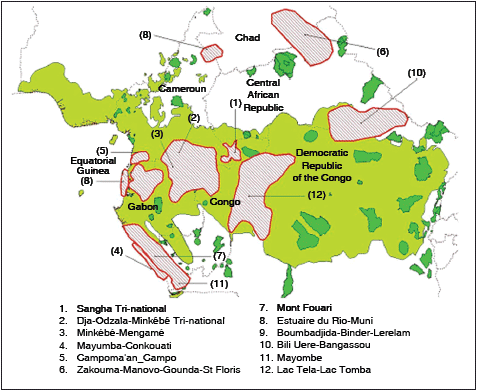 |
| 3 Sangha Tri-national landscape, with core protected area and multiple-use zones |
 |
Isolated pockets of protected areas and forest patches alone do not allow for effective conservation of biodiversity, given increased pressures due to unsustainable exploitation practices in the multiple-use zones that surround them. Large blocks of natural habitat, on the order of millions of hectares are needed to maintain viable species populations for resilience to large-scale disturbances such as climate change. The large landscape conservation approach adopted in the Congo Basin is aimed at effective management of a network of protected areas along with promotion of sustainable use of natural resources in surrounding forests for economic development, livelihood support and the well-being of surrounding local communities.
Success in managing large-scale and complex initiatives that cut across international boundaries and national priorities depends on an enabling institutional environment, which must address national sensitivities and the geopolitical context in the subregion. The COMIFAC treaty signed by Central African leaders addresses some of the geopolitical and strategic issues, forging cooperation and the commitment of member countries to work together. COMIFAC is now a legal entity empowered by the governments to take decisions and formulate regional policies to promote sustainable management of natural resources in the Congo Basin. The treaty is also an important benchmark towards harmonization of regional forestry laws, policies and governance systems.
The Yaoundé process has been a catalyst for regional cooperation and more efficient management of natural resources in the Congo Basin. Both the commitment of Central African leaders and support from the international conservation community have been critical in its success. The existence of a Congo Basin treaty has stimulated bilateral and multilateral funding agencies to commit funding for the Congo Basin basket fund.
One of the unique characteristics of the Yaoundé process and Congo Basin conservation initiative is the participatory nature in which the programme has been developed and is being implemented. It institutionalizes dialogue, participation and empowerment of stakeholders including local communities in land-use planning processes at grassroots levels, and as shown by the example of the Sangha Tri-national landscape described above, communities are benefiting.
The process has also demonstrated the value of rigorous scientific analysis in the development of large-scale conservation programmes. In the Congo Basin, priority landscapes and actions were determined following methodical assessment of the socio-economic and biological value of key sites.
Experiences and lessons learned from the Congo Basin would be useful for other regions confronted with similar problems, for example Latin America which also still has large areas of natural forest.
![]() Bibliography
Bibliography
Brunner, J. & Ekoko, F. 2000. Cameroon. In F.J. Seymour & N.K. Dubash, eds. The right conditions: the World Bank, structural adjustment, and forest policy reform, pp. 59–80. Washington, DC, USA, World Resources Institute.
Central Intelligence Agency (CIA), United States. 2007. The World Factbook 2007. Washington, DC, USA.
Congo Basin Forest Partnership (CBFP). 2006. The forests of the Congo Basin –state of the forest report.
Eves, H., Stein, J., Wilkie, D. & Bush Meat Crisis Task Force (BCTF). 2002. The bush meat crisis in West and Central Africa. Silver Spring, Maryland, USA, BCTF.
Hochschild, A. 1998. King Leopold’s ghost: a story of greed, terror, and heroism in colonial Africa. New York, USA, Houghton Mifflin Company.
International Tropical Timber Organization (ITTO). 2004. Annual Review and Assessment of the World Timber Situation 2003. Yokohama, Japan.
Parenti, C. & Hanna, L. 2007. The fight to save Congo’s forests. The Nation, 22 October. Available at: www.thenation.com/doc/20071022/parenti
Sayer, J.A. & Campbell, B.M. 2004. The science of sustainable development: local livelihoods and the global environment. Cambridge, UK, Cambridge University Press.
Wilkie, D.S., Sidle, J.G., Boundzanga, G.C., Blake, S. & Auzel, P. 2000. Defaunation or deforestation: commercial logging and market hunting in northern Congo. In R. Fimbel, A. Grajal & J.G. Robinson, eds. The impacts of commercial logging on wildlife in tropical forests. New Haven, Connecticut, USA, Yale University Press.
World Resources Institute (WRI). 2000. An overview of logging in Cameroon. Washington, DC, USA.
World Wide Fund for Nature (WWF). 2002. Strategic planning –Western Congo Basin Moist Forest Eco-region. Eco-region Technical Report. Libreville, Gabon, WWF Central Africa Regional Programme Office (CARPO).
WWF. 2008. Global 200. Internet document. Available at: www.nationalgeographic.com/wildworld/global.html